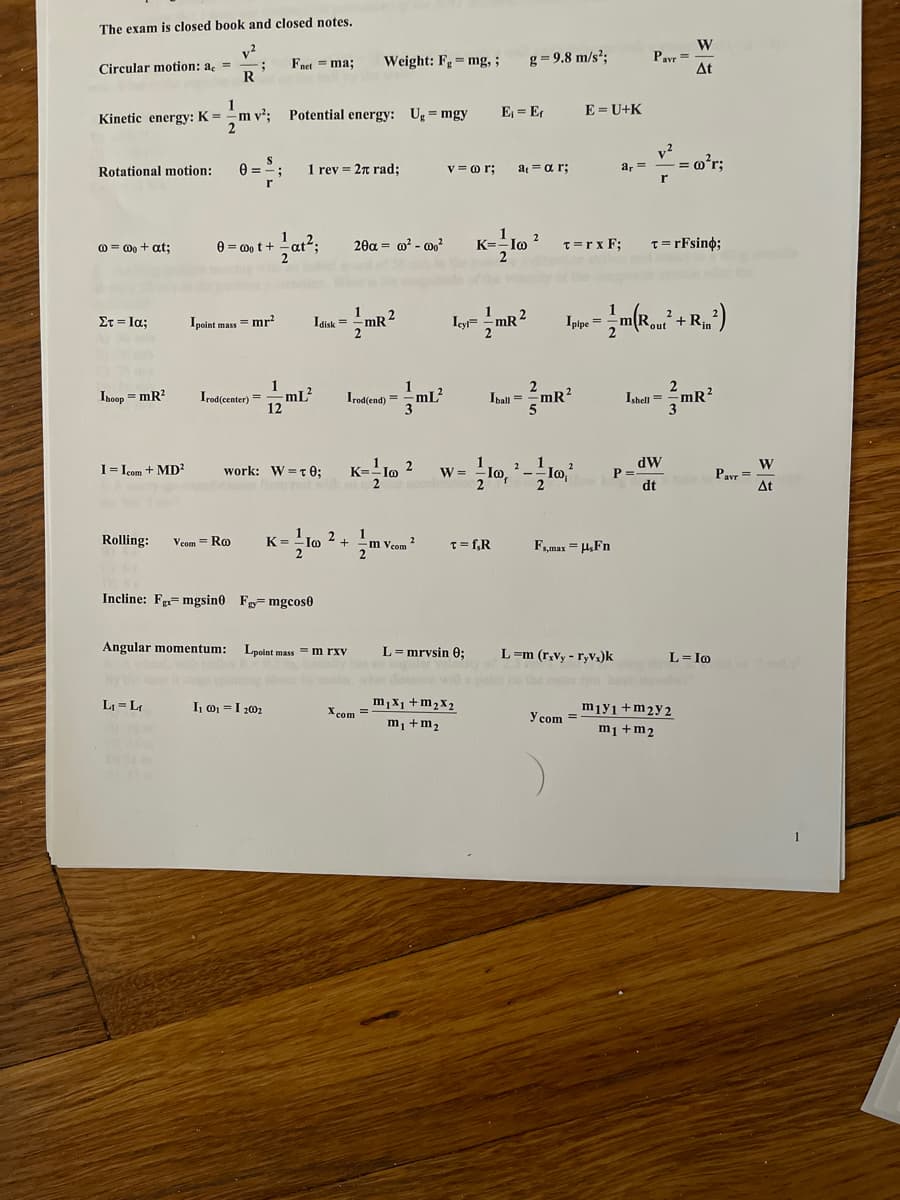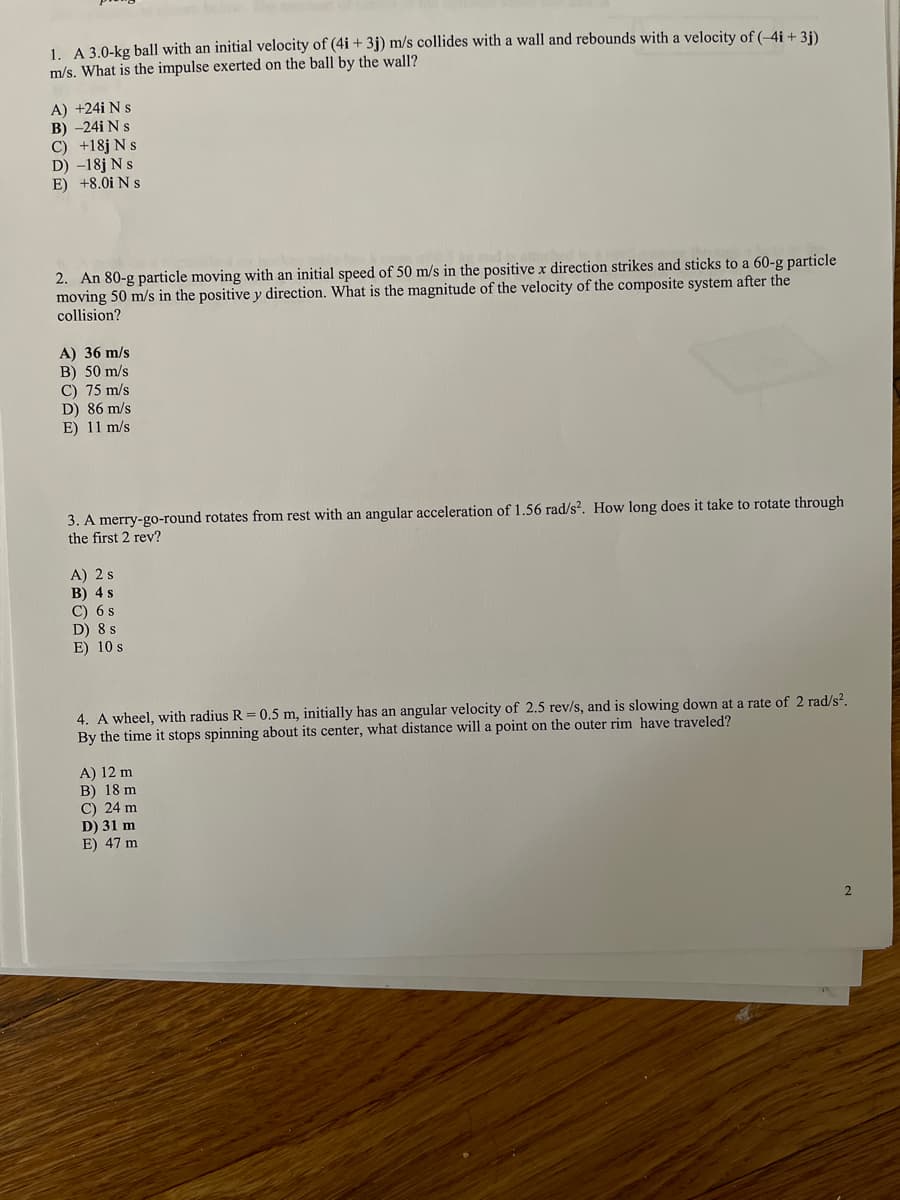1. A 3.0-kg ball with an initial velocity of (4i +3j) m/s collides with a wall and rebounds with a velocity of (-4i + 3j) m/s. What is the impulse exerted on the ball by the wall? A) +24i N s B) -24i N s C) +18j N s D) -18j N s E) +8.0i N s
1. A 3.0-kg ball with an initial velocity of (4i +3j) m/s collides with a wall and rebounds with a velocity of (-4i + 3j) m/s. What is the impulse exerted on the ball by the wall? A) +24i N s B) -24i N s C) +18j N s D) -18j N s E) +8.0i N s
College Physics
11th Edition
ISBN:9781305952300
Author:Raymond A. Serway, Chris Vuille
Publisher:Raymond A. Serway, Chris Vuille
Chapter6: Momentum, Impulse, And Collisions
Section: Chapter Questions
Problem 78AP: A 60-kg soccer player jumps vertically upwards and heads the 0.45-kg ball as it is descending...
Related questions
Question
Please explain me step by step following number 1,2,3,4 use provided formulas sheet plus don’t copy from chegg please

Transcribed Image Text:The exam is closed book and closed notes.
W
Pavr =
At
Weight: F= mg, ;
g= 9.8 m/s?;
Fnet = ma;
Circular motion: ac =
R
1
m v²;
Potential energy: Ug = mgy
E = E
E = U+K
Kinetic energy: K =
v2
Rotational motion: 0==;
= m°r;
1 rev = 2n rad;
v = o r;
at = a r;
a, =
r
0 = t+at?;
28a = o - o K= lo ?
0 = 0o + at;
T=rx F;
T= rFsino;
R2
2 + Rin
Στ-Ια;
Ipoint mass = mr?
Idisk =
2
2
:-
Ihoop = mR?
Irod(center) =
mL?
Irod(end) = mL?
Iball =
mR?
Ishell =
mR?
12
dW
P =
dt
W
Pavr =
At
I= Icom + MD?
work: W =t 0;
K=
2
W =
2
Rolling:
Vcom = Ro
K =
a Veom 2
T= f,R
Fmax = H,Fn
Incline: F- mgsin0 F=mgcos0
Angular momentum:
Lpoint mass =m rxv
L= mrvsin 0;
L=m (r,Vy - ryVa)k
L= Io
LI = L4
m,x1 +m2X2
mıy1 +m2y2
m1 +m2
I o =I 202
X com =
Усom
m, +m2

Transcribed Image Text:1. A 3.0-kg ball with an initial velocity of (4i + 3j) m/s collides with a wall and rebounds with a velocity of (-4i + 3i).
m/s. What is the impulse exerted on the ball by the wall?
A) +24i N s
B) -24i N s
C) +18j N s
D) -18j N s
E) +8.0i N s
2. An 80-g particle moving with an initial speed of 50 m/s in the positive x direction strikes and sticks to a 60-g particle
moving 50 m/s in the positive y direction. What is the magnitude of the velocity of the composite system after the
collision?
A) 36 m/s
B) 50 m/s
C) 75 m/s
D) 86 m/s
E) 11 m/s
3. A merry-go-round rotates from rest with an angular acceleration of 1.56 rad/s?. How long does it take to rotate through
the first 2 rev?
A) 2 s
B) 4 s
C) 6 s
D) 8 s
E) 10 s
4. A wheel, with radius R = 0.5 m, initially has an angular velocity of 2.5 rev/s, and is slowing down at a rate of 2 rad/s?.
By the time it stops spinning about its center, what distance will a point on the outer rim have traveled?
A) 12 m
B) 18 m
C) 24 m
D) 31 m
E) 47 m
Expert Solution
This question has been solved!
Explore an expertly crafted, step-by-step solution for a thorough understanding of key concepts.
This is a popular solution!
Trending now
This is a popular solution!
Step by step
Solved in 2 steps

Knowledge Booster
Learn more about
Need a deep-dive on the concept behind this application? Look no further. Learn more about this topic, physics and related others by exploring similar questions and additional content below.Recommended textbooks for you

College Physics
Physics
ISBN:
9781305952300
Author:
Raymond A. Serway, Chris Vuille
Publisher:
Cengage Learning

Physics for Scientists and Engineers with Modern …
Physics
ISBN:
9781337553292
Author:
Raymond A. Serway, John W. Jewett
Publisher:
Cengage Learning

College Physics
Physics
ISBN:
9781285737027
Author:
Raymond A. Serway, Chris Vuille
Publisher:
Cengage Learning

College Physics
Physics
ISBN:
9781305952300
Author:
Raymond A. Serway, Chris Vuille
Publisher:
Cengage Learning

Physics for Scientists and Engineers with Modern …
Physics
ISBN:
9781337553292
Author:
Raymond A. Serway, John W. Jewett
Publisher:
Cengage Learning

College Physics
Physics
ISBN:
9781285737027
Author:
Raymond A. Serway, Chris Vuille
Publisher:
Cengage Learning

Physics for Scientists and Engineers
Physics
ISBN:
9781337553278
Author:
Raymond A. Serway, John W. Jewett
Publisher:
Cengage Learning

Physics for Scientists and Engineers, Technology …
Physics
ISBN:
9781305116399
Author:
Raymond A. Serway, John W. Jewett
Publisher:
Cengage Learning
